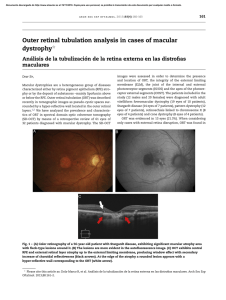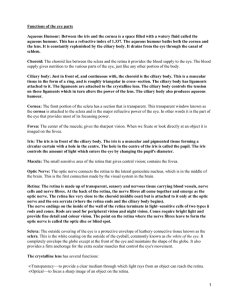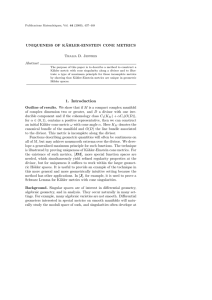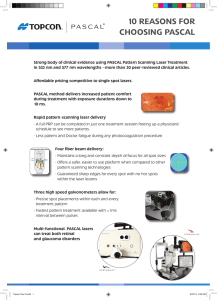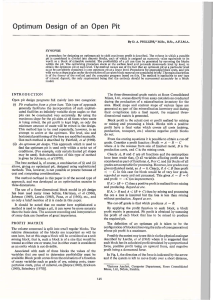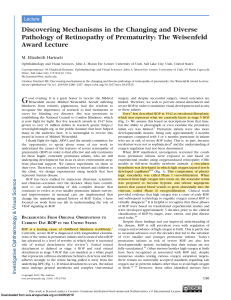Ultrastructure of the Outer Retina in the Killifish, Aphanius sirhani
Anuncio
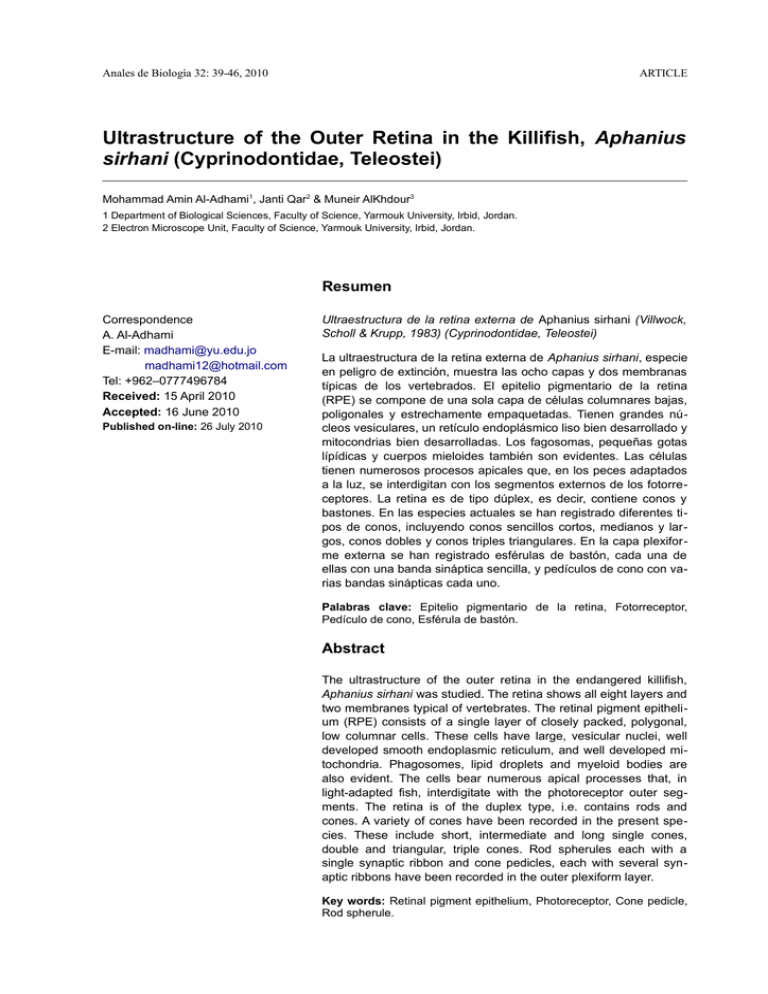
Anales de Biología 32: 39-46, 2010 ARTICLE Ultrastructure of the Outer Retina in the Killifish, Aphanius sirhani (Cyprinodontidae, Teleostei) Mohammad Amin Al-Adhami1, Janti Qar2 & Muneir AlKhdour3 1 Department of Biological Sciences, Faculty of Science, Yarmouk University, Irbid, Jordan. 2 Electron Microscope Unit, Faculty of Science, Yarmouk University, Irbid, Jordan. Resumen Correspondence A. Al-Adhami E-mail: madhami@yu.edu.jo madhami12@hotmail.com Tel: +962–0777496784 Received: 15 April 2010 Accepted: 16 June 2010 Published on-line: 26 July 2010 Ultraestructura de la retina externa de Aphanius sirhani (Villwock, Scholl & Krupp, 1983) (Cyprinodontidae, Teleostei) La ultraestructura de la retina externa de Aphanius sirhani, especie en peligro de extinción, muestra las ocho capas y dos membranas típicas de los vertebrados. El epitelio pigmentario de la retina (RPE) se compone de una sola capa de células columnares bajas, poligonales y estrechamente empaquetadas. Tienen grandes núcleos vesiculares, un retículo endoplásmico liso bien desarrollado y mitocondrias bien desarrolladas. Los fagosomas, pequeñas gotas lípídicas y cuerpos mieloides también son evidentes. Las células tienen numerosos procesos apicales que, en los peces adaptados a la luz, se interdigitan con los segmentos externos de los fotorreceptores. La retina es de tipo dúplex, es decir, contiene conos y bastones. En las especies actuales se han registrado diferentes tipos de conos, incluyendo conos sencillos cortos, medianos y largos, conos dobles y conos triples triangulares. En la capa plexiforme externa se han registrado esférulas de bastón, cada una de ellas con una banda sináptica sencilla, y pedículos de cono con varias bandas sinápticas cada uno. Palabras clave: Epitelio pigmentario de la retina, Fotorreceptor, Pedículo de cono, Esférula de bastón. Abstract The ultrastructure of the outer retina in the endangered killifish, Aphanius sirhani was studied. The retina shows all eight layers and two membranes typical of vertebrates. The retinal pigment epithelium (RPE) consists of a single layer of closely packed, polygonal, low columnar cells. These cells have large, vesicular nuclei, well developed smooth endoplasmic reticulum, and well developed mitochondria. Phagosomes, lipid droplets and myeloid bodies are also evident. The cells bear numerous apical processes that, in light-adapted fish, interdigitate with the photoreceptor outer segments. The retina is of the duplex type, i.e. contains rods and cones. A variety of cones have been recorded in the present species. These include short, intermediate and long single cones, double and triangular, triple cones. Rod spherules each with a single synaptic ribbon and cone pedicles, each with several synaptic ribbons have been recorded in the outer plexiform layer. Key words: Retinal pigment epithelium, Photoreceptor, Cone pedicle, Rod spherule. 40 A. Al-Adhami et al. Introduction Cyprinodonts (killifishes) are small-sized, euryhaline fish. Two species of killifish are found in Jordan. These are Aphanius sirhani (Villwock, Scholl & Krupp 1983), an endemic species to Azraq oasis; 80km ESE of Amman (3º49'N 36º48'E) and Aphanius dispar with a wide range of distribution extending from India to NE Africa. The fish feeds on small insects and crustaceans. Little is known about the biology, anatomy and histology of these two endangered species apart from a few taxonomical and physiological studies (Villwock et al. 1983). The present work on the structure of the retina in A. sirhani is a part of preparatory exploration for future investigation of the effect of changing environmental conditions, particularly desertification and rising temperature on the behavior and physiology of this critically endangered fish (IUCN 2009. IUCN Red List of Threatened Species). The teleostean retina has been, and still is, a focus for the attention of many researchers due to a number of features that characterize it (AlAdhami et al. 2003, Donatti & Fanta 2007). Of these features are the large sized, versatile photoreceptors (Al-Adhami & Mir 1999, Cameron & Easter 1995, Reckel & Melzer 2003), the peculiar, mosaic arrangement of photoreceptors (Cheng & Novales Flamarique 2007), the retinomotor movements that involve many constituents of the retina (McCormack & Donnell 1994, Braekevelt et al. 1998, Donatti & Fanta 2007). Finally, the capacity of the retina of regeneration (Cameron, 2000) and ongoing growth is well documented (Raymond & Hitchcock 1997, Cameron & Carney 2000). Material and Methods Fish samples were collected from Azraq Oasis during May- June, 2003. They were transported to the laboratory in containers filled with oasis water and reared in aquaria filled with the same water till the time they were sacrificed. The fish were either dark adapted for overnight or light adapted. They were anesthetized using tricane methanesulfonate (MS222), decapitated, and the eyes were quickly enucleated. The retinas were rapidly dissected out under a dissecting microscope. For light microscope studies, Anales de Biología 32, 2010 they were fixed in Bouin's fluid and routinely processed. Serial, 6 µm-thick, sections were stained in hematoxylin and eosin. For transmission electron microscope study, retina samples were sliced into small pieces, fixed in 2.5% gluteraldehyde in 0.1 M sodium cacodylate buffer at pH 7.3, postfixed in 1% OsO 4 in the same buffer, dehydrated in acetone and embedded in Spurr's resin. Sectioning was made by ReichertJung ultratome. Thin sections were stained with uranyl acetate and lead citrate to be examined with Zeiss EM 10 CR. Results The eyes of the fish understudy, i.e. A.sirhani, are somewhat large and are located on the lateral aspects of the small head. They are enclosed in a cartilaginous optic capsule (Fig. 1A). All eight layers and two limiting membranes typical of vertebrate retinas are well evident (Figs. 1A, 1B). The retinal pigment epithelium (RPE) consists of a single layer of polygonal, columnar cells with basally located, vesicular nuclei (Fig. 1C). These cells rest on the trilaminar Bruch's membrane (complexus basalis) characteristic of teleosts (Fig.1D). The membrane is made up of the basal lamina of the retinal epithelium and that of the choriocapillaris which embraces the retina and a thick layer of loosely-arranged collagen fibrils in between. The cells are loaded with myeloid bodies, phagosomes containing shed outer segments and melanosomes of variable shapes and sizes (Figs. 1C, 1D). The mitochondria are basally located, somewhat electron lucent and are spherical-oval in shape (Fig. 1D). Vitreally, the RPE cells form numerous melanosome-laden apical processes. These processes show clear retinomotor movements. During the day, the melanosomes are spread into the apical processes which, in turn, extend to shield the rod outer segments. The melanosomes are withdrawn into the somata of the pigment cells and the apical processes are retracted during the night (Figs. 1A, 1B). Wandering phagocytes are rarely encountered in the RPE near the apical processes -outer segments interface. They are irregularly outlined due to many cytoplasmic processes extending from the cell (Fig. 1E). The cells are characterized by a more electron dense cytoplasm than the surround- Anales de Biología 32, 2010 Ultrastructure of retina in Aphanius sirhani 41 Figura 1. A: Retina adaptada oscuridad mostrando todas las capas de la retina y la cápsula óptica (oc). g: capa de células ganglionares; in: capa nuclear interna; ip: capa plexiforme interna; on: capa nuclear externa; op: capa plexiforme externa; pe: epitelio pigmentario; flecha: membrana limitante interna. MO 100x. B: Retina externa (adaptada a la oscuridad) que muestra coriocapilares (cc), capa nuclear interna (in), capa nuclear externa (on), epitelio pigmentario (pe), segmentos externos de los bastones (flecha sombreada) y elipsoides de conos dobles (flecha blanca). MO 400x. C: Núcleos de células epiteliales pigmentarias (n) rodeados por citoplasma con numerosos melanosomas (flecha). MET 7.875x. D: Citoplasma de la zona basal de células pigmentarias retinianas mostrando mitocondrias (mi), fagosomas (ph) y melanoso mas (flecha). La membrana de Bruch (Bm) es bien patente. MET 15.625x. E: Fagocito emigrante con gran núcleo esférico (n). Pueden obser varse en el citoplasma numerosos cuerpos mieloides fagocitados (flechas), segmentos externos (ph) y melanosomas (mn). MET 5.000x. Figure 1. A: Dark-adapted retina showing all retinal layers and the optic capsule (oc). g: ganglion cell layer; in: inner nuclear layer; ip: inner plexiform layer; on: outer nuclear layer; op: outer plexiform layer; pe: pigment epithelium; arrow: inner limiting membrane. LM 100x. B: Outer retina (dark-adapted) showing choriocapillaris (cc), inner nuclear layer (in), outer nuclear (on) layer, retinal pigment epithelium (pe), rod outer segments (shaded arrow) and ellipsoids of double cones (white arrow) are shown. LM 400x. C: Nuclei of the retinal pigment epithelial cells (n) surrounded by melanosome-rich cytoplasm (arrow). TEM 7,875x. D: Basal cytoplasm of retinal pigment cells showing mitochondria (mi), phagosomes (ph) and melanosomes (arrow). Bruch's membrane (Bm) is evident. TEM 15,625x. E: Wandering phagocyte with a large, spherical nucleus (n). Many phagocytosed myeloid bodies (arrows), outer segments (ph) and melanosomes (mn) can be dis cerned in the cytoplasm. TEM 5,000x. 42 A. Al-Adhami et al. ing pigment cells, many melanosomes and phagosomes. No specialized intercellular junctions between the wandering phagocytes and the surrounding pigment cells could be detected (Fig. 1E). The retina is of the duplex type, i.e. it possesses rods and cones (Figs. 2A-B). Cones observed include the following types: single, unequal double (Figs. 2C) and triangular triple cones (Figs. 2D, 3A). Tangential sections show that single cones are of three length categories, long in the center of the square mosaic, intermediate at the outer junction between double cone and short (accessory corner) situated opposite to the subsurface membrane (Fig. 2C). Members of double and triple cones are separated from each other by complex subsurface cisternae (Figs. 2C-D). The latter extend almost along the entire photoreceptors and their pedicles. They are absent at the level of the tapering outer segments which are supported by several calycal processes (Fig. 3A). The inner segment of a photoreceptor is made up of a scleral, mitochondria-rich ellipsoid (Figs. 2A, 2C) and a slender myoid (Fig. 2B) that contains other organelles including the nucleus. The smaller and denser rod nuclei and the more vesicular larger cone nuclei constitute the outer nuclear layer (Figs. 1B, 2A). Each cone myoid terminates into a cone pedicle with several synaptic ribbons, while a rod myoid terminate into the smaller rod spherule which contains a single synaptic ribbon. These structures constitute the outer plexiform layer (Figs. 2A, 3B). All photoreceptors show retinomotor movement. In light adapted retinas, cone outer segments are exposed and rod outer segments are masked by the apical processes of the RPE. While cones are masked during the dark and the rods are exposed. The mechanism behind this does not lie in the retinomotor movements of the apical process of the pigment epithelium only, but in the photoreceptor myoids which have the capacity of shortening and elongation. Furthermore, the cones adjust their arrangement from square mosaic during light time (Fig. 2B) to linear mosaic at night. Cone pedicles, the bulbous ends of cone myoids, the smaller and more electron dense rode spherules and invaginating processes of horizontal and bipolar cell of the underlying inner nuclear layer (Fig. 3B) constitute the outer plexiform lay- Anales de Biología 32, 2010 er (Fig. 3B). A cone pedicle shows several synaptic ribbons and many invaginations, while a rod spherule usually shows a single synaptic ribbon and few invaginations (Fig. 3B). The inner nuclear layer shows a variety of second order neurons including horizontal, bipolar, Müller and amacrine cells (Fig. 3C). The inner plexiform layer underlies the INL and is made up of a variety of synapses and nerve fibers (Figs. 3C-D). A single row of ganglion cells of different sizes and morphology comprises the ganglion cell layer (GCL) and a layer of nerve fibers (NFL) represents the vitreal most layers (Figs. 3D-E). The inner limiting membrane (ILM) lines the retina on the vitreal side. Vitreal blood vessels are often seen adjoining the ILM (Figs. 3D-E). Discussion The histological and ultrastuctural pictures of the retinal pigment epithelium (RPE), and retina of A. sirhani are in general accordance with those described in other teleosts (Braekevelt et al. 1998, Reckel & Melzer, 2003). Some details of the above mentioned structures, however, reflect the behavior and photohabitat of the fish understudy. The photohabitat of A. sirhani is extremely labile due to a number of factors including surface waves, rains and clouds, sandy winds, daily and seasonal fluctuation of solar irradiance and zooand phytoplanktons. The size and location of the eyes are suitable for the shallow, almost stagnant water bodies of Azraq Oasis and suggest that the fish depends primarily on vision for detecting and procuring food (Horodysky et al. 2008). The retina seems highly active. This can be easily concluded from the presence of rich choriocapillaris network (Collin et al. 1996a, b), the vitreal vessels which have been recorded in a minority of the teleosts studied yet (Nag & Bhattacharjee 1993, Al-Adhami & Mir 1999, Wujcik et al. 2007) and the highly active phagocytotic activity of the retinal pigment epithelium (Breakevelt et al. 1998). The occurrence of wandering phagocytes, which have been recorded in a number of fish species, particularly in dark-adapted retinas is another indication of such activity (Braekevelt 1980, Braekevelt et al. 1998, Donatti & Fanta 2007). The different types of photoreceptors, particularly cones (Van der Meer & Bowmaker 1995, Anales de Biología 32, 2010 Ultrastructure of retina in Aphanius sirhani 43 Figura 2. A: Detalle de la figura 1B mostrando elipsoides de conos simples y dobles (dc) de la capa nuclear externa (on). Pedículos de los conos y esférulas de los bastones constituyen la capa plexiforme externa (op). Una fila de células horizontales (hc) y otras neuronas de segundo orden forman la capa nuclear interna (en). MO 400x. B: Capa de fotorreceptores que muestra segmentos externos de los bastones (ros), elipsoides de los conos (e) con cisternas sub-superficiales (punta de flecha) separando los miembros de conos dobles. Mioides (my) de conos. TEM 3.250x. C: Sección tangencial a nivel del elipsoide que muestra la organización en mosaico cuadrado de los conos. Isc: cono simple intermedio; lsc: cono simple largo; flecha: cisternas sub-superficiales entre miembros de conos dobles. MET 4.000x. D: Sección tangencial a nivel del elipsoide mostrando conos triples triangulares (ce): elipsoide de un cono, (mi): mitocondrias. MET 7.875x. Dinsertado: Detalles de las cisternas sub-superficiales (flecha) entre miembros de triple conos. MET 37.500x. Figure 2. A: Part of figure 1B magnified showing ellipsoids of single and double cones (dc) scleral to the outer nuclear layer (on). Cone pedicles and rod spherules constitute the outer plexiform layer (op). A row of horizontal cells (hc) and other second order neurons constitute the inner nuclear layer (in). LM 400x. B: Photoreceptor layer showing rod outer segments (ros), cone ellipsoids (e) with subsurface cisternae (arrowhead) separating members of double cones. Myoids (my) of cones are shown. TEM 3,250x. C: Tangential section at the ellipsoid level showing the square mosaic arrangement of cones. Isc: intermediate single cone; lsc: long single cone ssc: short single cone; arrow: subsurface cisternae between members of double cones. TEM 4,000x. D: Tangential section at the ellipsoid level showing triangular triple cones. ce: cone ellipsoid; mi: mitochondria. TEM 7,875x. D insert: Details of the subsurface cisternae (arrow) between members of triple cones. TEM 37,500x. 44 A. Al-Adhami et al. Anales de Biología 32, 2010 Figura 3. A: Sección tangencial que muestra segmentos externos de un cono triple triangular (cos) con varios procesos caliciformes rodeando cada uno de ellos (flecha negra). También están presentes un cilio conector (flecha blanca) y segmentos externos accesorios (aos). MET 7.875x. B: Capa plexiforme externa. Las esférulas del bastón (rs) son pequeñas y electronodensas. Los pedúnculos del cono (cp) son grandes, poco electronodensos y cada uno contiene varias cintillas sinápticas (flecha). MET 12.500x. C: Capas plexiforme interna (ip) y nuclear interna (in). Esta última muestra variedad de células: amacrinas (ac) y de Müller (Mc). MET 5,000x D: Capa de la fibra nerviosa (nf), vas vítreo (vv) y límite interno de la retina (flecha). MET 7,875x. E: Retina interna, incluyendo la capa plexiforme interna (ip), gélulas ganglionares (gc) y el vaso vítreo (vv). MET 7,875x. Figure 3. A: Tangential section showing outer segments of triangular triple cone (cos) with several caylical processes surrounding each of them (black arrow). Connecting cilium (white arrow) and accessory outer segments (aos) are shown TEM 7,875x. B: Outer plexiform layer. Rod spherules (rs) are small and electron dense. Cone pedicles (cp) are large, electron lucent and each containing several synaptic ribbons (arrow). TEM 12,500x. C: Inner plexiform layer (ip) and inner nuclear layer (in). The latter shows a variety of cells: amacrine cell (ac) and Müller cell (Mc). TEM 5,000x. D: Nerve fiber layer (nf), vitreal vessel (vv) and inner limiting membrane (arrow). TEM 7,875x. E: Inner retina including the inner plexiform layer (ip), ganglion cells (gc) and vetreal vessel (vv). TEM 7,875x. Anales de Biología 32, 2010 Ultrastructure of retina in Aphanius sirhani Reckel & Melzer 2003, Bailes et al. 2006), the different types of ellipsoidal mitochondria and the well developed cone pedicles with several synaptic ribbons and invaginating processes of horizontal and bipolar cells (Collin et al. 1996a, b) indicate that the retina of A. sirhani is particularly adapted to acute and colored vision (Nag & Bhattacharjee 2002). Moreover, the accessory corner (putative UV sensitive) cones reported during the present study apparently correspond to UV cones in several other fishes studied (Novales Flamarique 2000, 2001) and may indicate a capability of detecting UV light which sounds a reasonable adaptation for the photohabitat of the fish due to the shallow water bodies and the shiny days which predominate the year. Juveniles of many teleost species have UV cones which they loose as they grow. Members of some species, however, retain these cones through adulthood (Losey et al. 1999, Miyazaki et al. 2002). The profound retinomotor movements, whereby the cone outer segments are exposed to light during the day and rod outer segments during the night, and the high density of the versatile cones indicate a diurnal mode of life (Wang & Mangel 1996, Donatti & Fanta 2007). Yet, the numerous rod photoreceptors and their well developed spherules are signs of fairly good night vision (Ali 1975, Douglas 1982). Acknowledgement The authors would like to thank the Dean of Research and Higher Studies, Yarmouk University for providing transport during the collection of the specimens. References Ali MA. 1975. Vision in Fishes. Plenum Press, New York. Al-Adhami MA & Mir S.1999.Fine structure of the retina in Garra rufa (Cyprinidae, Teleostei). Dirasat 26 (2): 211-219. Al-Adhami MA, Qar J & Al-Khdour M. 2003. Embryonic fissure and photoreceptor differentiation in the eye of adult Garra rufa (Cyprinidae, Teleostei). Folia Biologica 49 (3-4): 183-190. Bailes HJ, Trezise AEO & Collin SP. 2006. The number, morphology, and distribution of retinal ganglion cells and optic axons in the Australian lungfish Neoceratodus forsteri (Krefft 1870). Visual Neuroscience 23: 257-273. 45 Braekevelt CR. 1980. Wandering phagocyte at the retinal epithelium-photoreceptor interface in the teleost retina. Vision Research 20: 495-499. Braekevelt CR, Smith, SA & Smith BJ. 1998. Fine structure of the retinal pigment epithelium of Oreochromis niloticus L. (Cichlidae: Teleostei) in light and dark-adaptation. Anatomical Record 252: 444-452. Cameron DA. 2000. Cellular proliferation and neurogenesis in the injured retina of adult zebrafish. Visual Neuroscience 17:1-9. Cameron DA & Carney LH. 2000 Cell mosaic patterns in the native and regenerated inner retina of zebrafish: Implications for retinal assembly. Journal of Comparative Neurobiology 416: 356-367. Cameron DA & Easter SS. 1995. Cone photoreceptor regeneration in adult fish retina: phenotypic determination and mosaic pattern formation. Journal of Neuroscience 15(3): 2255-2271. Cheng CL & Novales Flamerique I. (2007). Chromatic organization of cone photoreceptors in the retina of rainbow trout: single cones irreversibly switch from UV (SWS1) to blue (SWS2) light sensitive opsin during natural development. Journal of Experimental Biology 210: 4123-4135. Collin SP, Collin HB & Ali MA. 1996a. Fine structure of the retina and pigment epithelium in the creek chub, Semotilus atromaculatus (Cyprinidae, Teleostei). Histology and Histopathology 11: 41-53. Collin SP, Collin HB & Ali MA. 1996b. Ultrastructure and organization of the retina and pigment epithelium in the cutlip minnow, Exoglossum maxillingua (Cyprinidae, Teleostei). Histology and Histopathology 11: 55-69. Donatti L & Fanta E. 2007. Fine structure of the retinal pigment epithelium and cones of Antarctic fish Notohenia coriiceps Richardson in light and darkconditions. Revista Brasileira de Zoologia 24(1): 3340. Douglas RH. 1982. The function of photomechanical movements in the retina of the rainbow trout (Salmo gairdneri). Journal of Experimental Biology 96: 389403. Horodysky AZ, Brill RW, Warrant EJ, Musick JA & Latour RJ. 2008. Comparative visual function in five sciaenid fishes inhabiting Chesapeake Bay. Journal of Experimental Biology 211: 3601-3612. Losey GS, Cronin TW, Goldsmith TH, Hyde D, Marshall NJ, & McFarland WN. 1999. The UV visual world of fishes: a review. Journal of Fish Biology 54: 921943. McCormack CA, & Donnell MT. 1994.Circadian regulation of teleost retinal movement in vitro. Journal of General Physiology 103: 487-499. Miyazaki T, Iwami T, Somiya H, & Meyer-Rochow BM. 2002. Retinal topography of ganglion cells and putative UV-sensitive cones in two Antarctic fishes: Pagothenia borchgreviniki and Trematomus bernacchii (Nototheniidae). Zoological Science 19: 1223-1229. Nag, TC & Bhattacharjee J. 1993 Retinal vascularisation in the loach Noemacheilus rupicola: coexistence of 46 A. Al-Adhami et al. falciform process and vitreal vessels. Environmental Biology of Fishes 36: 385-388. Nag, TC & Bhattacharjee J. 2002. Retinal cytoarchitecture in some mountain-stream teleosts of India. Environmental Biology of Fishes 63: 435449. Novales Flamarique I. 2000. The ontogeny of ultraviolet sensitivity, cone disappearance and regeneration in the sockeye salmon, Onchorhynchus nerka. Journal of Experimental Biology 203: 1161-1172. Novales Flamarique I. 2001. Gradual and partial loss of corner cone-occupied area in the retina of rainbow trout. Vision Research 41: 3073-3082. Raymond PA & Hitchcock PF. 1997. Retinal regeneration: common principles but a diversity of mechanisms. Advances in Neurology 72: 171-184. Reckel F & Melzer R. 2003 Regional variations in the outer retina of Atherinomorpha (Beloniformes, Atheriniformes, Cyprinodontiformes: Teleostei): photoreceptors, cone patterns, and densities. Anales de Biología 32, 2010 Journal of Morphology 257: 270-288. Van der Meer HJ & Bowmaker JK. 1995. Interspecific variation of photoreceptors in four co-existing Haplochromine cichlid fishes. Brain Behavior and Evolution 45: 232-240. Villwock W. Scholl A. & Krupp F. 1983. Zur taxonomie, verbreitung und speziation des formenkreises Aphanius dispar (Ruppeli, 1828) und beschreibung von Aphanius sirhani n. sp. (Pisces: Cyprinodontidae). Mitteilungen aus dem Hamburg Zoologischen Museum und Institut 80: 251-277. Wang Y & Mangel S. 1996. A circadian clock regulates rod and cone input to fish retinal cone horizontal cells. Proceedings of National Academy of Science 93: 4655-4660. Wujcik JM, Wang G, Eastman JT & Sidell BD. 2007. Morphometry of retinal vasculature in Antarctic fishes is dependent upon the level of hemoglobin in circulation Journal of Experimental Biology 210: 815824.
